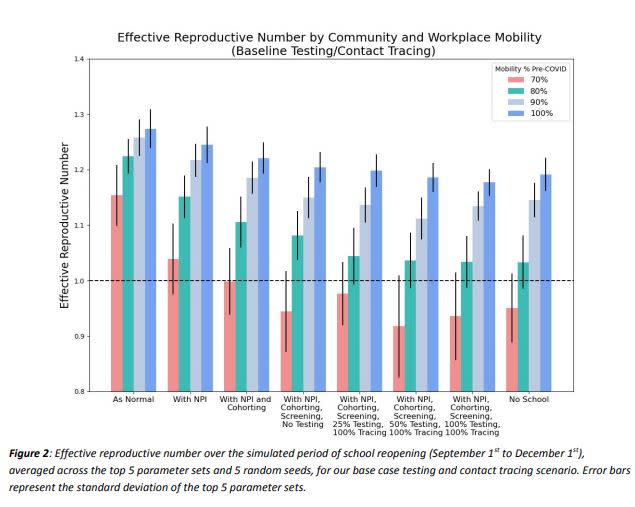Study: Reopening Schools Depends On Public's Help Managing Virus
SEATTLE, WA — Washington is less than 2 months away from the first day of school, but for many students it is still unclear whether their classes will reopen in-person or continue remotely. Now, researchers say, that depends on if the public is willing to do their part to slow the spread of the virus.
In early June, state Superintendent of Public Instruction Chris Reykdal told schools to prepare as if they would reopen classrooms in the fall, but to keep a backup plan in case they could not. Shortly after that, the state issued guidance telling colleges and universities how they could safely reopen, but warned that many schools may not be able to safely do so.
Then last week, the Trump Administration unveiled a new policy that would revoke the visas of international students studying in American colleges if their classes continued remotely. The plan was met with widespread condemnation, including a lawsuit from Washington state and a response from Gov. Jay Inslee who said that Washington would not be "bullied" into unsafely reopening their schools. That rule has since been rescinded, but such a strong response raises a question: is Washington really ready to safely reopen schools, especially considering the current surge in coronavirus cases?
Now, a new study is shedding light on the issue, with dire warning that, if schools are going to reopen, it's going to require more cooperation from the general population.
"It is telling us, at this time, there is too much COVID-19 transmission in our community to support school reopening," said Dr. Jeff Duchin, Health Officer for King County.
The report, created by the Bellevue-based Institute of Disease Modeling, used data from King County to create six models that predict how different reopening strategies could affect the pandemic. In the worst, where schools fully reopen without any countermeasures like masks or physical distancing, the study found the COVID-19 attack rate would double across the state in just three months. That includes in the general population, not just students.
"We can't think of schools in isolation, COVID isn't really just a schools problem," said Daniel Klein Senior Research Manager with the Institute for Disease Modeling.
For the study, researchers focused on the virus' "effective reproductive number" a variable which shows how many people each new coronavirus patient infects. The goal is to have a number below one: meaning the average patient infects less than one other person, and the number of infections shrinks over time.
Most of the models created for the study found that reopening schools would keep the effective reproductive number above one. However, there is a path forward, but only if the public takes precautions and if schools keep students grouped together, wear masks, screen and test students and staff, infection rates can be kept lower.

Many of those protections are already included in the state's guidance: reopening schools will be required to conduct screenings, test coronavirus patients before they can return to class or work, and require mask use inside school buildings.
"Basically, what these models are showing is these countermeasures in schools are necessary," said Klein.
But the biggest necessity, according to researchers: limiting the amount of travel for everyone in the whole community. The red bars in the graph above show scenarios where residents are only 70 percent as mobile as they were before the pandemic began. As the bars show, if residents are less mobile the infection rate drops dramatically.
In mid-June, cell phone data showed that King County was about 65 percent as mobile as it had been before the pandemic, though residents have become more mobile as travel restrictions have lifted. If the community continues to become more mobile, there is no way schools can reopen safely. As the study's authors write:
"However, under a scenario in which mobility in the community increases to 80% of pre-COVID levels, none of the mitigating strategies in schools we explored would be able to reduce the effective reproductive number to one or below, meaning the epidemic will grow."
In other words, if Washington wants schools to reopen, that will be dependent on how the community handles the virus in the coming weeks.
"The most important step we can take to reopen schools this fall is to come together to reduce spread of the virus in our communities and statewide," said Lacy Fehrenback, Deputy Secretary for COVID-19 Response with the Washington State Department of Health.
Only time will tell if the community can contain the virus enough to allow schools to safely reopen, but surging coronavirus cases over recent weeks have not left health officials overly optimistic. Monday, the state reported 1,101 new cases of the coronavirus, the highest daily case count so far, and Tuesday the governor announced that the state would not allow counties to reopen any further for at least two more weeks because of the surge in cases.
"If we continue to head in the wrong direction, it will be extremely difficult to bring students back to school," said Duchin.
Related stories:
Washington Schools Plan To Return To Classrooms This Fall
Washington Outlines How Colleges, Universities Can Return In Fall
Inslee: We Will Not Be Bullied Into Unsafely Reopening Schools
Washington Sues Over ICE Policy On International Student Visas
This article originally appeared on the Seattle Patch

